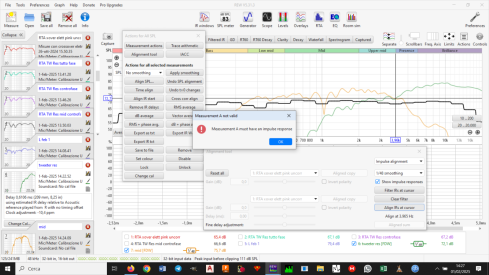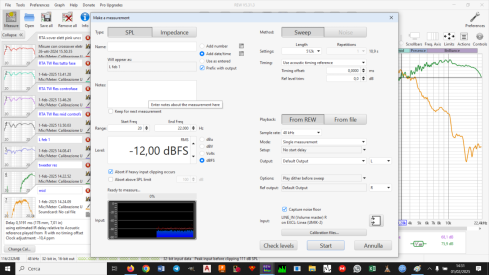For capturing accurate timing/phase, any standard XLR mic and 2 channel audio interface should be preferred over a USB mic solution. Timing reference is easily captured just with a loopback connection on the other channel of the interface, all you need is a short patch cable. It avoids the need to set up an acoustic reference, and keeps a constant timing reference for all measurements, so phase information includes complete time of flight from speaker to mic. Easy peasy.
-
AUDIO VIDEO PROCESSING, SETUP & ENVIRONMENTOfficial REW (Room EQ Wizard) Support Forum Audiolense User Forum Calibration Equipment Auto-EQ Platforms / Immersive Audio Codecs Video Display Technologies / Calibration AV System Setup and Support Listening Room / Home Theater Build Projects Room Acoustics and Treatments AV Showcase Movies / Music / TV / Streaming
-
AUDIO VIDEO DISCUSSION / EQUIPMENTHome Theater / Audio and Video - Misc Topics Essence For Hi Res Audio AV Equipment Advice and Pricing Awesome Deals and Budget AV Equipment AV Receivers / Processors / Amps UHD / Blu-ray / CD Players / Streaming Devices Two Channel Hi-Fi Equipment DIY Audio Projects Computer Systems - HTPC / Gaming HD and UHD Flat Screen Displays Projectors and Projection Screens AV Accessories Buy - Sell - Trade
Navigation
Install the app
How to install the app on iOS
Follow along with the video below to see how to install our site as a web app on your home screen.
Note: This feature may not be available in some browsers.
More options
You are using an out of date browser. It may not display this or other websites correctly.
You should upgrade or use an alternative browser.
You should upgrade or use an alternative browser.
Acoustic phase Measurements
- Thread starter Gmauro
- Start date
HI Jon, i'm hera again with new trouble about timming alignement. TRyingh again with procedure that you explained in past, today i've this error message, and i'm not able to complete measurments. see atteeched. Any help or idea why?
Attachments
Of course. But this RTA whas showed automatically, i don't know why, and i'm not able to remove it. The error message is displayed selecting the 2 correct SPL measurments of mid and tweeter with acoustic timing reference.RTA measurements don't contain any impulse / phase information.
It seems like a mistery....
Ops... you are in right place. Sorry.Your screenshot shows that you have selected the RTA measurements in the alignment tool. Recommend downloading the latest REW beta, it will not allow RTA measurement selection in the alignment tool.
My stupid mistake.....!

Popular tags
20th century fox
4k blu-ray
4k uhd
4k ultrahd
action
adventure
animated
animation
bass
blu-ray
calibration
comedy
comics
denon
dirac
dirac live
disney
dolby atmos
drama
fantasy
hdmi 2.1
home theater
horror
kaleidescape
klipsch
lionsgate
marantz
movies
onkyo
paramount
pioneer
rew
romance
sci-fi
scream factory
shout factory
sony
stormaudio
subwoofer
svs
terror
thriller
uhd
ultrahd
ultrahd 4k
universal
value electronics
warner
warner brothers
well go usa
















